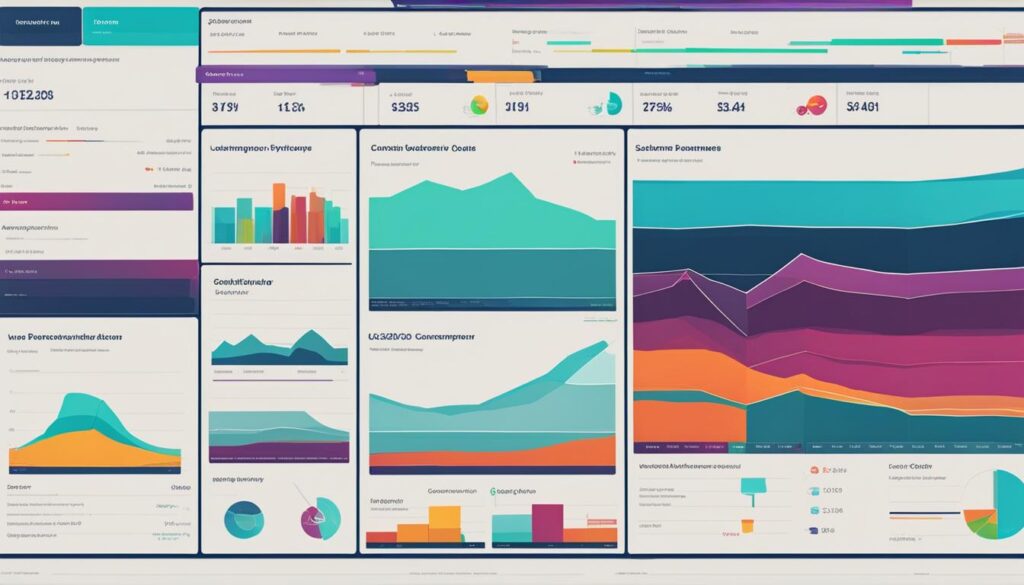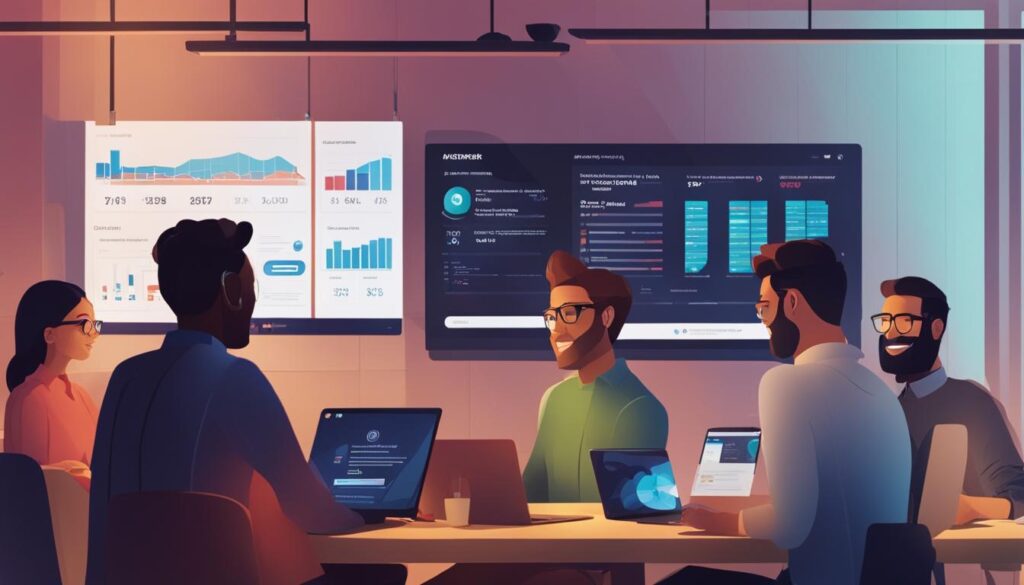Strategies to Boost Customer Retention in SAAS

In the highly competitive Software as a Service (SAAS) industry, customer retention is paramount to achieving sustainable revenue growth and ensuring business success. According to research, 80% of a company’s future revenue comes from just 20% of its existing customers, highlighting the importance of keeping subscribers engaged and reducing SAAS churn through effective retention strategies.
Customer retention refers to the ability of businesses to maintain ongoing relationships with their customers, resulting in continued product usage and subscription renewals. In the SAAS industry, where customer acquisition costs can be high and competition is fierce, retaining customers is vital to long-term business success.
Key Takeaways:
- Customer retention is crucial for SAAS businesses to achieve sustainable revenue growth.
- 80% of future revenue comes from 20% of existing customers.
- Retaining customers is more cost-effective than acquiring new ones.
- Retention strategies focus on keeping subscribers engaged and reducing churn.
- Effective retention strategies can improve customer loyalty and increase revenue for SAAS businesses.
Understanding Customer Churn in SAAS
In the competitive SAAS industry, customer churn can be detrimental to business success. Customer churn refers to the number of customers who cancel their subscriptions over a given period. There are several reasons why customers may choose to churn, including dissatisfaction with the product or service, lack of perceived value, and poor customer support. It’s important for SAAS businesses to understand and address these reasons for churn to improve customer retention rates and sustain growth.
SAAS churn rates vary depending on the nature of the product, the target audience, and the market. According to a report by ProfitWell, the average annual customer churn rate for SAAS businesses is 5.2%. While this may seem like a small percentage, it can result in considerable revenue loss over time.
The Benefits of Customer Retention
Customer retention is a vital aspect of any SAAS business’s success, as it directly impacts revenue and customer loyalty. Utilizing effective retention strategies can help reduce churn and provide a competitive edge in the market. Let’s dive into the benefits of customer retention:
- Increased revenue: Retaining existing customers is much cheaper than acquiring new ones. According to research, a 5% increase in customer retention can lead to a 25% increase in profits.
- Improved customer loyalty: Customers who stick around for a longer period are more likely to become loyal advocates for your brand, leading to positive word of mouth and increased credibility.
- Competitive edge: Customers are always on the lookout for the best value and experience. Providing excellent customer retention strategies ensures a competitive advantage in the SAAS industry.
Clearly, customer retention is a key factor in determining the success of a SAAS business. By understanding its benefits, you can implement effective retention strategies and create a loyal customer base in the long run.
Tracking and Analyzing Customer Behavior
In today’s competitive SAAS industry, understanding customer behavior is critical in improving retention rates. By tracking and analyzing data on their needs, preferences, and pain points, businesses can personalize their offerings and provide better customer experiences, ultimately leading to increased customer loyalty and retention.
One effective way to collect customer behavior data is through analytics tools like Google Analytics or Mixpanel. These tools can provide businesses with valuable insights into customer behavior, such as how often they use the product, which features they use most frequently, and how long they spend on certain tasks.
Another method is through customer feedback surveys, where subscribers can provide feedback on their experience with the product, what they value most, and what areas could be improved. This information can be used to identify patterns and potential reasons for cancellation, and take proactive measures to address and minimize churn.

By analyzing customer behavior and using this data to drive product development and personalized marketing, businesses can improve customer experiences, reduce churn, and increase retention rates over time.
Building a Strong Onboarding Process
A strong onboarding process is vital for setting the foundation of the customer’s experience with the SAAS product. It is the first impression of the product and can impact customer engagement and retention. An effective onboarding process should guide users through the product’s features and functionalities, providing a clear understanding of how it works.
The onboarding process should also emphasize the value of the product to the customer, demonstrating how it can address their specific pain points. A personalized approach to onboarding by tailoring it to the customer’s needs can increase customer satisfaction and retention.
Employing interactive tutorials, knowledge bases, and guided tours can make the onboarding process engaging and enjoyable, improving the user’s likelihood of becoming a paying customer. Providing comprehensive support material like FAQs, user manuals, and live chat support is also essential to ensure the customer feels supported.
A visually appealing and user-friendly onboarding process that provides context and guidance can increase customer engagement and retention, setting the stage for a successful and long-lasting customer relationship.
Enhancing Customer Support and Communication
Providing excellent customer support and maintaining open lines of communication with subscribers is crucial for any SAAS business looking to boost customer retention and reduce churn. Customers crave exceptional customer service, and when businesses deliver on that, it fosters trust and builds loyalty.
One critical aspect of quality customer support is fast, responsive communication that caters to the customer’s needs. Businesses should aim to offer 24/7 customer support via multiple channels, including email, phone, and live chat, ensuring quick resolution of customer queries or concerns.
By leveraging customer communication channels, businesses can also gather insights that can help improve their SAAS product and services. Surveys, feedback forms, and social media interactions can help businesses gather customer feedback, quickly identify problems, and make the necessary changes to address those problems while enhancing customer experience.
To sum it up, providing excellent customer support through open communication channels and timely resolution of customer issues is a powerful retention strategy that can boost customer loyalty, trust, and ultimately lead to an increased customer retention rate.

Offer Personalized Recommendations and Features
In the world of SAAS, personalization has become a key factor in retaining customers. By offering personalized recommendations and features, businesses can increase customer engagement and satisfaction, ultimately leading to higher retention rates. Personalization can be achieved through various means, such as analyzing customer behavior data and tailoring product offerings based on their interests or by implementing machine learning algorithms to suggest relevant content.
A study conducted by Accenture found that 91% of consumers are more likely to shop with brands that provide personalized recommendations. Similarly, a SmarterHQ survey found that personalized emails have a 29% higher open rate and 41% higher click-through rate than generic ones. These statistics highlight the importance of personalized recommendations and features in keeping customers engaged and happy with the product.
Examples of Personalized Recommendations and Features
Spotify, a popular music streaming service, uses machine learning algorithms to analyze user behavior, such as search history and listening habits, to provide personalized playlists and music recommendations.
Netflix‘s recommendation engine suggests movies and TV shows based on user viewing history, ratings, and preferences. This ensures that users are presented with content that aligns with their interests and viewing habits, increasing user engagement and retention.
| Benefits of Personalized Recommendations and Features |
|---|
| Increased user engagement and satisfaction |
| Higher retention rates |
| Improved cross-selling and upselling opportunities |
Personalized recommendations and features provide businesses with a competitive edge in the SAAS market, ensuring that customers are presented with content that resonates with their individual needs and interests. Implementing this retention strategy can drive user engagement and ultimately lead to higher retention rates.
Implementing a Loyalty Program
Implementing a loyalty program is a proven strategy to boost customer retention and foster brand loyalty. By rewarding customers for their continued support, businesses not only increase retention rates but also encourage repeat purchases.
A loyalty program can take many forms, such as points-based systems, tiered rewards, or exclusive access to special features or events. The key is to design a program that aligns with your SAAS product and customer needs.
For example, renowned graphic design and publishing platform Canva offers a loyalty program that rewards subscribers with Canva Credit for referring friends, completing surveys, and using certain features. The Credit can be used for purchasing premium elements or upgrading to higher subscription tiers. This program not only incentivizes customers to remain subscribed but also encourages them to engage with the product and invite others to join.
Implementing a loyalty program requires careful planning, execution, and tracking of its effectiveness. Businesses must define the program’s rules, rewards, eligibility criteria, and communication strategy, considering factors such as customer demographics, revenue goals, and budget constraints. It’s important to test and iterate the program based on customer feedback and performance metrics to ensure it delivers the intended results.
 Incorporating a loyalty program into your retention strategy can not only benefit your customers but also your business’s bottom line. When customers feel appreciated and valued, they are more likely to stay loyal and recommend your product to others.
Incorporating a loyalty program into your retention strategy can not only benefit your customers but also your business’s bottom line. When customers feel appreciated and valued, they are more likely to stay loyal and recommend your product to others.
Regularly Engaging and Educating Subscribers
One of the most effective retention strategies for SAAS businesses is to regularly engage and educate subscribers with valuable content and updates. By doing so, subscribers remain actively interested in the product and can benefit fully from all its features.
One way to engage subscribers is by sending personalized emails featuring recommended content or highlighting new product updates. This not only keeps subscribers informed but also helps them feel valued as individuals. SAAS businesses can also create a customer portal where subscribers can access educational resources such as how-to guides, video tutorials, and user manuals. This encourages self-service and empowers subscribers to make the most of the product’s features.
Another great way to engage subscribers is through social media platforms. By consistently posting helpful content, SAAS businesses can keep subscribers updated and engaged. It’s important to keep content fresh and relevant to subscribe needs.
Regularly engaging and educating subscribers ensures that they remain invested in the product, leading to increased customer loyalty and retention rates.
Conducting Customer Surveys and Feedback Analysis
Customer surveys are a valuable tool for gaining insight into customer needs, preferences, and pain points. Analyzing the data gathered from these surveys can help SAAS businesses identify areas of improvement and enhance the customer experience to increase retention rates. Implementing surveys at key touchpoints throughout the customer journey, such as after the onboarding process or following customer support interactions, can provide valuable feedback and help SAAS businesses stay proactive in meeting customer needs.
In addition to surveys, businesses can also gather feedback through other means such as customer reviews and social media monitoring. Analyzing these data sources can provide a comprehensive view of customer sentiment and identify areas for improvement.
By taking feedback into account and making necessary improvements, SAAS businesses can demonstrate that they value their customers’ opinions and are committed to providing an excellent experience, ultimately leading to increased customer retention.
Continuous Product Development and Innovation
One of the most critical factors in retaining customers in the SAAS industry is continuous product development and innovation. SAAS businesses must continuously adapt to meet the changing requirements of their clients while also staying ahead of the competition.
By gathering customer feedback, businesses can identify areas for improvement and better understand the pain points of their customers. This data can then be used to shape future product updates and features, keeping customers engaged and providing more value from the product.
Continuously updating and improving the product can also help businesses stay ahead of the competition. By providing new and innovative features, SAAS companies can differentiate themselves from their competitors and offer unique value to their customers.
Monitoring and Addressing Customer Churn
In the SAAS industry, high customer churn rates can significantly impact business success. Therefore, it is crucial to monitor customer churn rates, identify patterns, and potential reasons for the cancellations. By doing so, SAAS businesses can take proactive measures to address and minimize churn effectively.
One effective strategy to address churn is to send a customer satisfaction survey to assess the customers’ perception of the product or service. The SAAS business can then analyze the feedback and work to make improvements that address the concerns raised by customers. In some cases, a negative experience can be turned into a positive one if the right steps are taken. By maintaining open lines of communication with customers, SAAS businesses can address concerns promptly, provide excellent customer service, and retain their subscribers.
SAAS businesses should analyze their churn data regularly to identify trends and patterns. Once identified, they can take proactive measures to improve the product or service and reduce churn.
Conclusion
In conclusion, implementing effective customer retention strategies is crucial for SAAS businesses to reduce churn rates and increase revenue. By understanding customer churn and behavior, building a strong onboarding process, providing excellent customer support, offering personalized recommendations and loyalty programs, engaging subscribers with valuable content and updates, gathering customer feedback, continuously innovating products, and monitoring and addressing churn, SAAS businesses can boost customer retention and achieve long-term success in the market.
FAQ
What is customer retention?
Customer retention refers to the ability of a business to retain its existing customers over a period of time. It involves implementing strategies to encourage customers to continue using a product or service, reducing the likelihood of them canceling their subscription or switching to a competitor.
Why is customer retention important in the SAAS industry?
Customer retention is crucial in the SAAS industry because it directly impacts a company’s revenue and long-term success. Acquiring new customers can be costly, so it’s more cost-effective to focus on retaining existing customers who are already familiar with the product. Additionally, loyal customers are more likely to provide positive reviews and referrals, helping to attract new customers.
What are some customer retention strategies for SAAS businesses?
There are several effective customer retention strategies for SAAS businesses, including tracking and analyzing customer behavior, building a strong onboarding process, enhancing customer support and communication, offering personalized recommendations and features, implementing a loyalty program, regularly engaging and educating subscribers, conducting customer surveys and feedback analysis, and continuously developing and innovating the product.
How can tracking customer behavior help with customer retention?
Tracking customer behavior allows SAAS businesses to gain insights into their customers’ interactions with the product. This data can be used to understand customer needs, preferences, and pain points, enabling businesses to personalize their offerings, provide targeted recommendations, and improve the overall customer experience. By catering to individual needs and preferences, businesses can increase customer satisfaction and retention.
Why is a strong onboarding process important for customer retention?
A strong onboarding process sets the tone for the customer’s experience with the SAAS product. It ensures that new customers understand how to use the product effectively, experience its value early on, and feel confident in their decision to subscribe. A smooth onboarding process increases customer engagement and reduces the likelihood of churn.
How can customer support and communication impact customer retention?
Excellent customer support and open lines of communication are essential for building trust and maintaining strong relationships with customers. When customers feel supported and valued, they are more likely to continue using the SAAS product. Promptly addressing customer concerns, providing timely assistance, and actively seeking feedback can significantly contribute to customer retention.
Why are personalized recommendations and features effective in customer retention?
Personalized recommendations and features make customers feel understood and catered to. By leveraging customer data and behavior, SAAS businesses can offer tailored suggestions and features that align with each customer’s needs and preferences. This customization enhances the customer experience and increases the likelihood of continued subscription.
What are the benefits of implementing a loyalty program for customer retention?
Implementing a loyalty program rewards customers for their continued support and encourages them to stay engaged with the SAAS product. Loyalty programs can enhance customer satisfaction, foster brand loyalty, and incentivize customers to stick with the product instead of exploring alternatives. This ultimately improves customer retention rates.
How can regularly engaging and educating subscribers help with customer retention?
Regularly engaging subscribers through valuable content, education, and updates keeps customers actively using and benefiting from the SAAS product. By providing ongoing value and demonstrating the product’s relevance, SAAS businesses can strengthen customer loyalty and reduce churn.
How can customer surveys and feedback analysis contribute to customer retention?
Customer surveys and feedback analysis allow SAAS businesses to gather valuable insights directly from their customers. This data can be used to identify areas for improvement, enhance the customer experience, and address any pain points or concerns. By listening to customer feedback and taking action, businesses can increase customer satisfaction and retention.
Why is continuous product development and innovation important for customer retention?
Continuous product development and innovation are necessary to meet evolving customer needs and stay ahead of the competition. By regularly updating and improving the SAAS product, businesses can ensure it remains valuable and relevant to customers. This ongoing commitment to innovation strengthens customer loyalty and helps retain customers.
Why is monitoring and addressing customer churn important for customer retention?
Monitoring customer churn rates allows SAAS businesses to identify patterns and potential reasons for cancellations. By proactively addressing these issues, businesses can make improvements to reduce churn and retain more customers. Understanding the reasons for churn helps businesses optimize their strategies and deliver better customer experiences.
